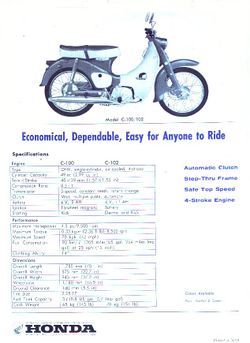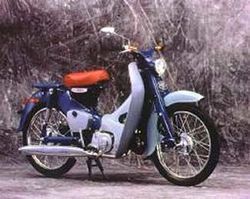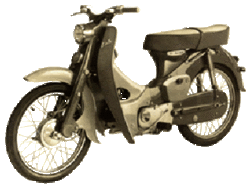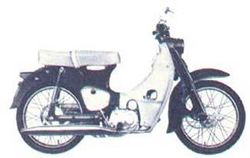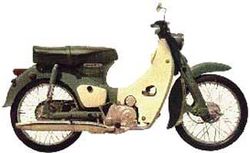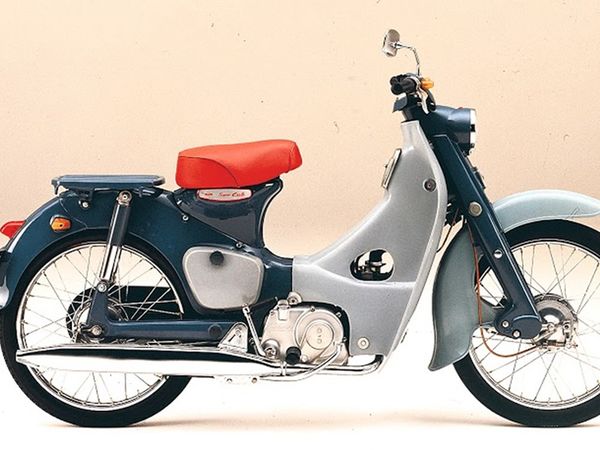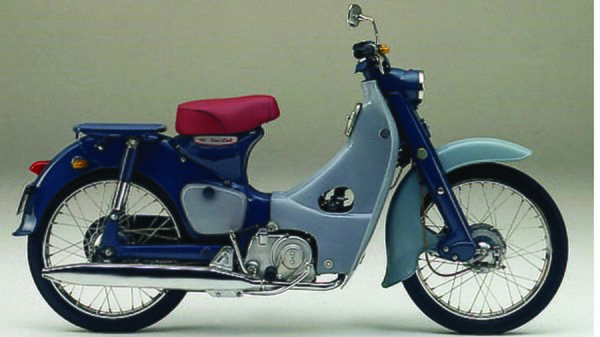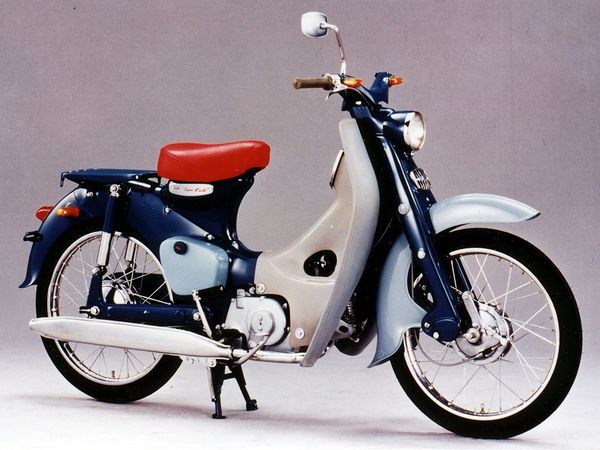Honda C100 Super Cub: history, specs, pictures
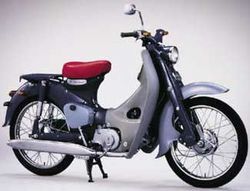 |
|
| Honda C100 Super Cub | |
| Manufacturer | |
|---|---|
| Also called | Super Cub Honda 50 |
| Production | 1958 - 1967 |
| Class | Scooter |
| Engine | air-cooled, four-stroke, single cylinder, OHC |
| Bore / Stroke | 40.6mm x 40.6mm |
| Compression ratio | 8.5:1 |
| Top Speed | 40mph |
| Horsepower | 4.96 HP (3.7 KW) @ 9500RPM |
| Torque | 2.21 ft/lbs (3.0 Nm) @ 8500RPM |
| Fuel System | carburetor |
| Spark Plug | NGK C7HSA |
| Transmission | Gear box: 3-speed, semi-automatic Final Drive: chain |
| Suspension | Front: leading link Rear: dual shocks |
| Brakes | Front: drum Rear: drum |
| Front Tire | 2.25 x 17 |
| Rear Tire | 2.25 x 17 |
| Wheelbase | 46.5 inches (1181 mm) |
| Length | 70.12 inches (1781 mm) |
| Width | 22.4 inches (569 mm) |
| Weight | 65.0 kg (wet) |
| Recommended Oil | Honda GN4 10W-40 |
| Related | Honda C70 |
| Competition | Suzuki MA Yamaha MF1 |
| Manuals | Service Manual |
The Honda C100 is a 50cc, single cylinder, four stroke, street motorcycle manufactured by Honda beginning in 1958 through today and more commonly known as the Honda Supercub.
History[edit | edit source]
With more than 60 million sold worldwide, it is the best selling powered vehicle of all time and thus the best-selling motorcycle of all time. This 50cc Honda is still produced today, 50 years after its inception. Out of all the brilliant bikes produced by Honda; the CB750 superbike, Mike Hailwood's magnificent six-cylinder racers, even the mighty Gold Wing, there is little doubt that the most important of all of them is the Honda C100 Super Cub of 1958.[1] The first one was sold in August 1958. If there is one motorized vehicle that can be said to have brought mobility to the masses it is the Super Cub. It can be thought of as the first scooterette, a totally new type of machine that had many characteristics of a scooter but featured large 17 in wheels and stability of a motorcycle proper. It featured an enclosed drivetrain, step-through frame, and protective leg shields clearly derived from scooter designs. The most innovative feature of the Super Cub was its plastic front fender and leg shields, the first use of plastic within the motorcycle world.[2] Plastic proved every bit as functional as steel in these applications, but with much less weight and at a considerably lower cost. After two years of production Honda was the world's biggest manufacturer. By 1960 over a half a million Super Cubs were sold every year, with a peak of 900,000 in 1963.[1]
It was first exported to the US in 1959 with the start of the American Honda Motor Company. In 1960 Honda introduced the electric start C102 Super Cub; the CZ100 monkey bike, with its similar enginge but tiny balloon tires; and the C110 Sports Cub. In 1962 Honda dropped the Super Cub name and simply began to call it the Honda 50. In 1963 Honda introduced the CA102T ( a US only trail-riding version of the Honda 50) featuring knobby tires, a larger rear sprocket, and the removal of the front fender and leg guards. In 1964, two larger engined versions were offered, the CM90 (OHV 87cc) and C65 (OHC 63cc) with slight alterations to frame and styling. Around 1967, the whole motorcycle was uprated, the 50cc engine going from pushrod 4.5bhp to SOHC 4.9bhp (a bored-down C65 engine) called the C50, and similarly the 90cc was redesigned with an OHC engine called the C90. Though the basic design of Cub remained unchanged, slightly new styling features and improvements were integrated, most visible being the enclosed front forks. In the 1980s, Honda fitted a new capacitor discharge ignition system (CDI) to replace the earlier contact points ignition, thereby helping to meet increasingly strict emission standards in markets such as the US. However, many experts on the Cub testify to the fact that Honda used the CDI system for better reliability and fuel efficiency, with the emissions improvements being an appealing by-product of these goals.
"You Meet the Nicest People on a Honda"[edit | edit source]
That it sold superbly well would be understating the obvious. It was backed by one of the best advertising campaigns ever - "You meet the nicest people on a Honda", with illustrations showing many different types of people enjoying the ride - it rapidly became the best-selling motorcycle of all time. The "Nicest People" ad originated with the Gray Advertising in Los Angeles, and it appeared in general interest magazines like Life and even in upstart and radical publications like Playboy, before making its way to television. The campaign proved key to starting Honda's huge export drive. Just 3 years before they had overtaken Tohatsu as the leading Japanese motorcycle manufacturer. In the US it completely changed the image of motorcycles, as much of the affluent public had previously thought that only greasy gangsters rode bikes due to the image conveyed by the Hell's Angels and films such as The Wild One.
1958-67 C100[edit | edit source]
The C100 was the original Honda Super Cub, launched in 1958 in Japan, then in the USA and Europe.
- Available originally only in blue with pale blue plastic parts, and later in various other colors for the world's different markets. (brown for japan, green for Britain to name two)
Many small details were changed in the first couple of years of production, but the final visible change was the adoption of a larger tail light in late 1962.
- The words "Cub" and "Super Cub" logos appear on the front legshield and fuel tank emblem in some countries, others havig 'Honda 50' badges.
- The tail light was flush mounted
- Starter: only a kick starter
- Single or dual seat depending on country of sale.
1962-70 Honda CA100[edit | edit source]
The CA100 (and CA102 electric start) was the US-specific version of the C100. It was available in a wider range of colurs (white and black were US only) and lacked the direction indicators (turn signals) fitted for all other markets. The CA100 featured the European spec tail-light after 1962 (Japanese bikes had a smaller triangular type) otherwise it was just like a C100 (indeed some frame numbers start C100!) In Japan and Europe the C100 was replaced by the OHC engined C50 in 1966-67, but the CA100 carried on in the US until 1970.
- Available four colors: Scarlet Red with White; White; Blue with White; and Black with White.
- Engine: 49cc OHV single cylinder
- Transmission: 3-speed with an automatic clutch
- Starter: only by a kick starter
- The logo on the front cowl and the base of the seat says, "Honda 50"
- It also has a larger tail light mounting bracket than the early model.
- Spark Plug: NGK C7HSA
1960-67 Honda C102[edit | edit source]
This was an electric-start version of the C100.
- Available in the same colors as the C100, depending on country of sale.
- Engine: 49cc OHV single cylinder
- Transmission: 3-speed with an automatic clutch
- Starter: unlike the similar C100, it had an electric starter.
- Spark Plug: NGK C7HSA
Other Images[edit | edit source]
References[edit | edit source]
- ↑ 1.0 1.1 Roland Brown (May 1991). Honda: the complete story. Crowood. ISBN 9781852235444. http://books.google.com/books?id=BBzaAAAACAAJ. Retrieved 10 December 2010.
- ↑ Aaron Frank (12 July 2003). Honda Motorcycles. MotorBooks International. ISBN 9780760310779. http://books.google.com/books?id=CSxTaoGagKoC. Retrieved 9 December 2010.
| Motorcycles: CB series | CBF series | CM/CMX series | CX Series | CBR series | NSR series | CR series | Pacific Coast | XR/XL series | Bros/HawkGT | VF/VFR series | VT series | VTX series | ST series | Valkyrie series | GL series| NR series |
| Mopeds and light motorcycles: Ape models | Cub series | CT series | ST series/Dax | S series |Wave series | Z series |
- Scooters
- Honda motorcycles
- Honda Cub motorcycles
- 1950s motorcycles
- 1960s motorcycles
- 1970s motorcycles
- 1980s motorcycles
- 1990s motorcycles
- 2000s motorcycles
- Street motorcycles
- 50cc displacement motorcycles
- 50cc 4-stroke motorcycles
- 50cc Single cylinder motorcycles
- 4-stroke motorcycles
- Single cylinder motorcycles
- Single cylinder 4-stroke motorcycles
- Honda scooters
